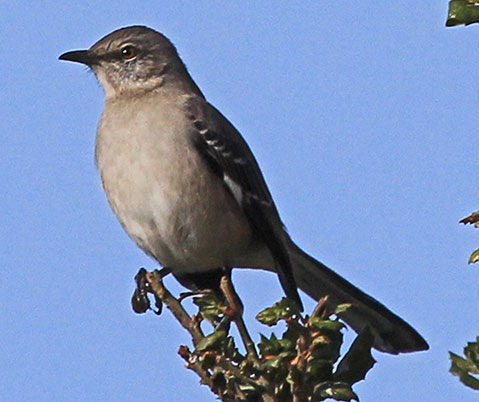Backyard Wildlife: Mockingbirds
Can You Learn to Love These Noisy, Winged Creatures?

I stayed at a hotel near Cottage Hospital once, and I soon discovered that a northern mockingbird was staying there also. At first this bird annoyed me, especially as it seemed to sing all night and kept me awake. Soon, however, my annoyance turned to fascination, and I researched the species online. Later, when I went home, I studied up on mockingbirds in all of my bird books.
The northern mockingbird is not particularly rare and is found in a variety of habitats. It is quite commonly observed in Santa Barbara and in other urban and suburban areas. This bird is known for its loud, mimicking song. The scientific name of the northern mockingbird, Mimus polyglottos, means “many-tongued mimic” due to the fact that these birds can mimic many sounds.
They most often imitate the sounds of various birds, but their repertoire may also include sounds such as those of frogs and car alarms. Mockingbirds continue to learn new sounds throughout their lives and have been known to learn as many as 200 sounds. A mockingbird will often sing 10-15 different songs at a stretch, and it will repeat each one several times before going on to a new song.
These birds are very territorial and are nearly always seen singly. They are omnivorous and feed on fruit, seeds, insects, earthworms, and sometimes even lizards. Last year I spent a long time watching and listening to a mockingbird in my orchard. This bird had set up residence in my persimmon tree, with its glowing orange fruit, and seemingly defended the tree against invaders as a soldier might defend his or her fort.
Mockingbirds are also known for their intelligence. They have been shown to recognize individual humans and may act defensively when confronted with a person who has previously threatened them. They will even choose to return to nest in an area where they have successfully nested in a previous season.
Both male and female northern mockingbirds look alike and are fairly ordinary looking. They are medium-sized, pale gray birds with short bills and long tails. They do, however, have striking white outer tail feathers and white wing patches that flash when they fly.
Formerly director of education at the Santa Barbara Botanic Garden, Sally Isaacson is now the education/volunteer coordinator at the Land Trust for Santa Barbara County’s Arroyo Hondo Preserve at Gaviota.



